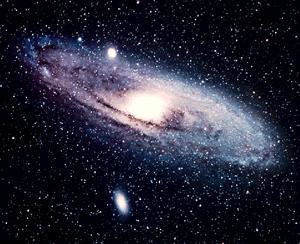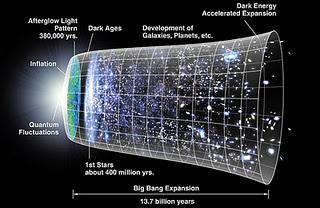
Part of the 17-mile-long LHC particle accelerator
Late last year there was breathless excitement within the physicscommunity as several experiments conducted by CERN [1] at the Large Hadron Collider [2] underGeneva seemed to hint at the presence of a fundamental, and as yet entirely theoretical,particle: the Higgs boson. What is this particle and why did these experimentsso energize physicists? The short, simple answer is that the Higgs boson is theparticle associated with the Higgs field, which is hypothesized to be a ubiquitousquantum “field”. Think of it as a force or condition throughout all of spacethat matter interacts with. It is theorized that Higgs bosons interact withother fundamental particles (electrons, quarks, etc.) to give them mass. Ifdetected, the Higgs boson would further validate the so called Standard Modelof particle physics, one of the core theories of how the universe (thefundamental particles and forces) is structured.The news from CERN quickly spread to the general news media andNewsweek jumped to exclaim on a cover headline that the experiments hinted at, “TheMeaning of the Universe.” Other publications picked up on the Higgs boson’snickname as “the God particle”. These headlines and reactions create theimpression that this discovery, if confirmed [3], would explain many of theremaining questions in theoretical physics and provide the answers to thoseeternal questions that have puzzled mankind for millennia. So would it?
The Profound Questions
The Higgs boson would explain why particular particles have a specific mass.Mass is a fundamental feature of matter and explaining how mass “works” wouldbe a tremendous breakthrough. The results would also be important in the understandingof mass-less particles like photons. But the discovery would hardly answer theeven more fundamental questions about the nature of the universe, such as:
- What is the universe?
- Where did it come from?
- Why does it have the structure and forces that it does?
- Is there anything outside of the universe?
- What is the universe’s fate?
Everything to (Practically)Nothing

The Milky Way
There’s a terrific website – scaleofuniverse.com – that provides aninteractive depiction of the size of the universe and everything in it. It’s away to conceptualize just how inconceivably vast the totality of the universeis, and how absurdly infinitesimal are its fundamental parts. Let’s take aquick scan of this reality. Make a fist and stare at it, image it is the entireuniverse and you’re looking at it like God:- Our universe is estimated to be 93 billion light years across. Light, traveling at 186,000 miles per second, would take 93 billion years to cover the current expanse of the universe.
- We can observe about 14 billion of these light years, the approximatetime that light has had to travel since time began (14 billion years ago, giveor take). The universe inflated faster than light a short time after the BigBang.
- We zoom way way in to our galaxy, the Milky Way, one out of hundreds ofbillions, and a mere 120,000 light years across, 0.0000086 times the distanceof the observable universe.
- We focus further, much further, to our solar system, which includingthe Oort Cloud, is 0.15 light years across, 1.5 trillion kilometers, or 0.0000013times the distance of the whole Milky Way.
- We continue closer and see the dim Sun from Pluto, nearly six billionkilometers distant, 0.004 times the diameter of the Oort Cloud.
- We pass Jupiter, 800 million kilometers from the Sun, 0.125 times thedistance from Pluto to the Sun.
- We see the Sun, shining nuclear-bomb bright, one star out of hundredsof billions in our galaxy, nearly 1.4 million kilometers across, 0.0018 thedistance to Jupiter.
- We close in on the Earth, one planet of likely hundreds of billions inthe Milky Way, almost 13,000 kilometers in diameter, just a spec compared tothe Sun.
- We see China spread 4,000 kilometers across the Earth’s surface.
- We see Mount Everest standing nearly 9 kilometers tall.
- We see a man standing on the summit, less than 2 meters (6 feet) tall.
- He steps on a snowflake a centimeter (.01 meters) across.
- And wishes on an eyelash 0.1 millimeters (.0001 meters) thick, justabout as thin as the human eye can detect.
- His heart vigorously pumps blood through his veins and he rapidlyexhales moist air, red blood cells and air droplets, both about 0.00001 metersacross.
- The moisture includes water molecules 0.0000000003 (3x10^-10) metersacross.
- Each molecule includes two hydrogen atoms, each just 0.00000000003 (3x10^-11)meters across.
- The nucleus of those atoms is 0.00000000000001 (1x10^-14) metersacross.
- The proton inside the nucleus is 0.000000000000001 (1x10^-15) metersacross.
- The quarks [4] inside the proton (and the electron circling the nucleus)are 0.000000000000000001 (1x10^-18) meters across.
- Preons, the building blocks of quarks are 0.000000000000000000001 (1x10^-21)meters across.
- Neutrinos, the ghostly particles the fly virtually untouched throughall of matter are smaller yet, just 0.000000000000000000000001 (1x10^-24) metersacross.
- And finally to the smallest of the smallest, the theoretical stringsand Plank length (the “minimum” length of anything) at0.00000000000000000000000000000000001 (1x10^-35) meters across.
I doubt the human mind can truly conceptualize the size of anything onscales larger than the solar system or smaller than a cell (I can’t anyway). Wecan see the Sun and have sent space probes past Pluto. We can see the thicknessof a piece of paper and understand its even smaller constituent parts. Yet thegreat unanswered questions lie beyond these narrow boundaries of observationand intuition.
Physics and Fantasy

Newton pushed knowledge forward
The human mind has done a miraculous (though maybe ingenious would be abetter term) turn in piecing together this reality over the last 3,000 years. AsAlan Lightman recently wrote, observation, experiment, and theorizing haspushed us – we think – to the very bounds of existence, from the buildingblocks of all space and time to the edge of the universe; from worshiping gods thatcontrolled the winds and the tides to general relativity and quantum mechanics;from Aristotle to Copernicus to Newton to Einstein to today’s geniuses. But somany “whys” remain. Why do forces (gravity, electro-magnetism, weak and strongnuclear forces) act on matter as they do? Why only these forces? Why do thefundamental particles (electrons, quarks, photons, to name a few) have the intrinsicqualities they do (mass, charge, spin, etc.)? Why this array of fundamentalparticles? Where did all this stuff (matter and energy) come from? In short,why is the universe like it is and behave like it does?As knowledge has grown, so have the mysteries. In the last couple ofdecades, physicists have confirmed that the great bulk of the stuff (matter andenergy) in the universe is comprised of dark matter and dark energy (combined about96% of the total). Dark matter doesn’t interact with the electro-magneticforce, so we can’t observe it directly, but it bends light from distantgalaxies with its cumulative gravity (gravitation lensing), so we know it’sthere. Dark energy is spreading intergalactic space apart at an acceleratingrate. Science has nothing more than theories about what these are. As noted,the fundamental particles have intrinsic characteristics, like the mass of anelectron. This (mass) may be the result of how electrons interact with theHiggs field and its Higgs bosons, but still, even if we can explain themechanism, does that tell us why the values are the way they are?
Physicists generally agree that if any of the intrinsic properties ofmatter or the strength of the fundamental forces was even a tiny bit different,the universe would not be the way it is. A tiny change to gravity and matterwouldn’t clump together, no stars, no planets. Small changes in the strength ofthe nuclear forces and nuclear fusion wouldn’t occur, no oxygen, or carbon, orany heavy elements. The universe as we know it and life as we understand it arepossible because of the exact intrinsic properties of matter and forces. That,to science, is an uncomfortable result. A seemingly inexplicable and random setof values that govern everything; Science wants an answer to the “why”.

A depiction of an 11-dimension "string"
Many theoretical physicists believe they have found the answer: String Theory. In a much abbreviated explanation [5], String Theory holds that the fundamentalforces and particles are made up of tiny vibrating “strings” the size of thevery smallest realm of space. The manner in which the strings vibrate givesrise to the intrinsic properties of particles and forces. In a way, this is asimple and elegant explanation. But very strangely, String Theory requiresthere not to be our familiar four dimensions (three of space and one of time)but 10 or 11 dimensions. Where are these weird, impossible-to-conceive-ofdimensions? According to String Theory, they’re bundled up on the tiniest of spacialscales and therefore invisible to observation. Sound strange? Well the more welook the stranger the universe appears. However, String Theory for all of itselegance and promise is nothing more than a theory. The details exist on ascale of space that we can’t observe or test, and probably never will be ableto observe or test. We don’t even have real equations to test because the mathis so complicated, but instead rely on approximations from math we can model. StringTheory might be right, but we may never be able to prove it.One offshoot of String Theory is the calculation that the geometry ofan eleven-dimension reality could take many forms, something like 1x10^500, anumber so huge that for practical reasons can be considered infinite. Every oneof these geometries would give rise to different string vibrations and hencedifferent intrinsic values for the fundamental particles and forces. This ideahas been extended to posit the existence of other universes, one for every possiblegeometry. This is one possible form for what physicists term the multi-verse.Our universe isn’t everything, just one of a practically infinite number ofuniverses. Think about this for a second. Does a multi-verse seem possible? Itmight be. How can we say that it isn't' possible? We can only see part of our ownuniverse, let alone detect the presence of elements that exist outside of ouruniverse (if they’re there). But again, like String Theory, it likely can neverbe tested, never observed, never proved. Beyond our universe, by most people’sperspectives, is beyond our reach.
There are in fact several other theories about the multi-verse. Some ofthem are even used to explain the Big Bang. Stephen Hawking, the renownedphysicists and theoretician, has even suggested that the Big Bang itself neednot to have been the event that started time and the universe as we understandit. Instead the universe may have an indeterminate, hazy, origin [6].Time and the universe didn’t start at a point but existed in some form before. Isthis possible? Perhaps, after all we cannot simulate conditions at the exactmoment of the Big Bang because all physical reality breaks down at a “singularity”,something math can’t handle. But again, can this idea ever be tested? If not,is it even science?
It seems that modern theoretical physics is reaching for answers to allthe “whys” listed above. Is it physics or fantasy? The Higgs boson, as Gregg Easterbrook wrote, would be a bit of cosmic plumbing, but hardly an explanationfor everything. String Theory and the multi-verse may represent man’s ultimatetriumph in understanding the universe (or universes), or they might be dead ends.Either way, lacking real evidence, supporters of these ideas must take thempurely on faith.
Universal Awareness
Whenever we ask the “why” questions, ponder the origin and fate of theuniverse, and try and understand why things are the way they are we rub againstthe edge of science and enter into philosophy and even theology. The Big Bang, andthe size, complexity, and detail of the universe, all could lead to God. Anempiricist (and this writer is one) is tantalized by the amazing strides we asa species have taken to understand the universe. It’s remarkable really. But itseems that to understand everything we need to observe everything. We need tosee before the Big Bang, we need to see outside of the universe. We need to seesmaller than the smallest distance of space and beyond the 14 billion-year-old coneof the visible universe. We need to see as God might see.
What’s more likely or unlikely, that in an infinite number of universesthat exist somewhere at sometime (in what and when no one can say) we inhabitone that has the properties that have allowed the Earth, and life, and humansto evolve and ask these questions and look for their answers? Or that ouruniverse, entirely at random, exploded into existence in a form that allowed usnow to exist? Or that we live in a universe created specifically so the Earth,and life, and humans could emerge to ask the “big” questions? Or is there someother explanation yet?

The aging universe.
One thing we can be certain of is that there is a beauty and wonder andmiracle that the universe has evolved and that we, made up of the very fabricof the universe, part of it and subject to all its rules, can marvel in itscomplexity and search for its meaning. In at least this one place and one form theuniverse has made itself aware. Perhaps there is nothing more amazing thanthat.
There are many theories for how the universe may end. It could ripitself apart as space expands forever, or maybe it will die a cold death asmatter spreads out and cools through entropy. In such scenarios the universefor all intents and purposes dies. All will be lost. The questions we ask, theknowledge we gained, the civilization we created, our Earth, our Sun, the solarsystem, and everything else will be gone. The universe faces the same mortaldilemma as we individual humans do. Viewed one way this is sad and depressingand begs the question many people have asked about their own lives: What doesit all mean? I wonder if there is an answer to that question, if it’s one forscience to explain, or if an answer will come from somewhere else.
---
NOTES:
[1] The European Organization for Nuclear Research.
[2] State-of-the-art, very large (matching its name) with acircumference of 17 miles, and very expensive with a final costs, includingupgrades, in the tens of billions of dollars.
[3] Researchers expect to have enough data to make a call on theexistence of the Higgs boson by the end of this year (2012).
[4] Readers will not be surprised by my pointing out that the term quarks was borrowed from Jame Joyce's Finnegans Wake.
[5] And I’m no expert, so please refer to Brian Greene’s The Elegant Universe and The Fabric of the Cosmos for more expansiveand expert explanation.
[6] See his recent The GrandDesign, which for full disclosure I have only read reviews of.

